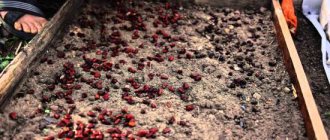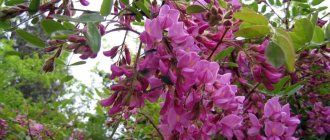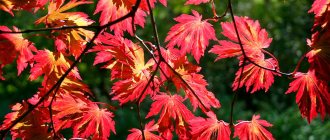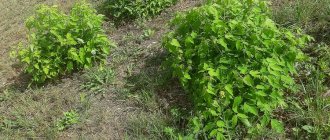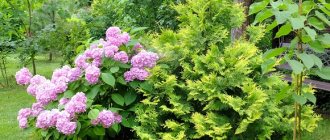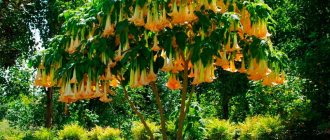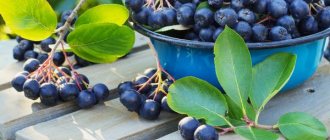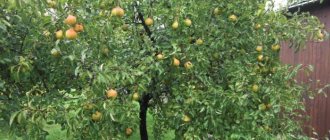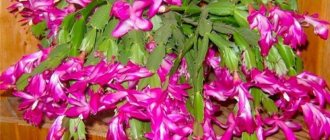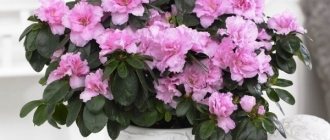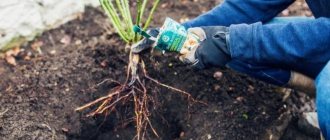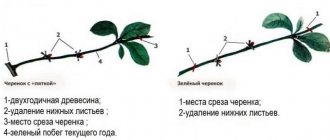Landing Features
It is necessary to plant maple seeds at a depth of 3-4 cm with the wings facing up.
If there are no plans to replant young plants in the future, then the distance between trees should be maintained at least 2 meters. The emergence of seedlings occurs 2-3 weeks from the moment of planting. It is worth knowing that maple growth occurs at a slow pace: by autumn the height of young trees usually reaches 20-40 cm, and in the first year of growth this figure reaches 80 cm. Caring for young trees is simple and consists of timely watering, regular weeding and ridding the plant of weeds. On hot days, it is recommended to shade young trees from direct sunlight. Depending on the size, young maple trees can be planted in a regular growth location after 1-3 years. Planting should be done in holes dug in advance, about 70 cm deep, and the width should be at least half a meter. If groundwater is close to the soil surface, the bottom of the hole should be covered with a 15-centimeter layer of sand or expanded clay.
Planting maple from seeds is a long-term and worthwhile investment in the future of your own garden. Several generations of descendants will rest under the shade of this luxurious tree.
Bonsai is a small tree with a strangely shaped trunk and crown. Its history stretches back to ancient times, to China, but it was in Japan that bonsai turned from just unusual plants into real art. Today, both the trees themselves and the method of their cultivation are designated by the word “bonsai”. How to grow such a miracle at home? How long will it take for an ordinary indoor plant or tree seedling to turn into a self-sufficient decorative element? How to grow bonsai from pine or dwarf deciduous trees? We’ll talk about everything that might interest you in this Japanese art in the article below.
Red maple - varieties
Thanks to the efforts of breeders from all over the world, there are a huge number of varieties of decorative red maple. Shrub varieties of maple have become especially popular for self-cultivation. Red maple foliage can change color depending on the season. In the spring, red leaves may bloom on the tree, in the summer the crown may turn green, and in the fall - purple-burgundy. Some varieties of red maple have green leaves with red edges. Consider the most popular varieties of red maple:
- red maple "Scanlon" is a deciduous tree that can reach 12 meters in height. The maple crown has a regular pyramidal shape. The trunk is straight, covered with light bark. Red maple foliage is green in summer and turns deep purple in fall. The root system of this type of red maple has a rod shape. The tree is unpretentious and grows well even on depleted soils. But when choosing a planting site, you should avoid heavy clay soils;
- red maple "Brandywine". The variety is characterized by fairly rapid annual growth. An adult tree grows up to 10-12 meters, and the crown reaches up to 6 meters in diameter. The variety is decorative due to its regular oval-shaped crown and the purplish-red color that the leaves acquire in the fall. The root system of the red maple variety "Brandywine" has a rod shape. The variety is known for its good frost tolerance, but its negative attitude towards prolonged heat. In an area that is too dry and dense, the maple will grow more slowly and the autumn color will not be as rich;
- red maple "Magnificent Magenta". This maple variety grows up to 12 meters in height. The beautiful oval shape of the crown gives the tree an attractive appearance. The leaves change color depending on the season. In the summer, the maple attracts attention with its lush green foliage, which, with the arrival of autumn, turns into provocative red, burgundy, and purple hues. Maple prefers to grow in sunny areas with light, nutritious soil;
- red maple "October Glory". A mature tree can reach 18 meters in height. Lush green foliage looks impressive when combined with light-colored bark. The crown has a pointed pyramidal shape. In summer, the leaves are green in color, and in autumn they acquire rich burgundy and purple shades. Maples of this variety grow worse on heavy clay soils with low concentrations of nutrients;
- red maple "Red Sunset". The variety was bred in the USA and was loved by many gardeners for its rapid growth rate and ease of care. An adult tree can reach 15-18 meters in height. The maple crown has the shape of a wide pyramid. The trunk is covered with light-colored bark, the shoots are painted in a reddish tint, which looks incredibly impressive in combination with both green leaves in summer and crimson leaves in autumn. Red maple variety “Red Sunset” can be successfully grown even in regions with cold winters with temperatures down to minus 30 degrees. The tree prefers light soils and does not like dense soil or long droughts;
- Red maple "Summer Red" is a small tree, usually growing to 10-12 meters in height. The maple crown has a round or oval shape. The color of the leaves makes the variety particularly decorative. They can be either soft green or red, orange, crimson, with a purple tint. In autumn, the leaves stay on the branches for a long time. Like most other varieties of red maple, the Summer Red maple prefers well-lit areas, areas with light and fertile soil;
- red maple "Sun Valley" is an excellent option for a compact deciduous tree with spectacular autumn leaf color for the site. The tap root system of the maple is located close to the surface of the earth and has many thin roots. Maple leaves reach 10 cm in length and have 3-5 lobes. In summer the foliage is green, in autumn it is bright red. Distinctive features of the variety are good frost resistance, low wind resistance, poor tolerance to lack of moisture;
- red maple "Somerset" is a deciduous tree of compact size. The crown has a slightly elongated shape and does not tend to thicken. Maple leaves have a shiny, smooth surface, are green in summer, and turn rich red in autumn. The variety is excellent for growing in urban conditions; in dry weather it requires additional watering;
- red maple “Candy Ice” . The tree has a pyramid-shaped crown, which becomes more rounded over time. The decorative effect of the variety is given by the special coloring of the leaves. In summer you can find whitish, pink, and green spots of irregular shape on them. In autumn the crown takes on a scorching fiery color;
- red maple "Morgan" is a deciduous tree, under favorable conditions reaching 20 meters in height. Maple leaves immediately after appearance have a brown or bronze tint, then they turn green, and with the arrival of autumn they acquire a rich red color. The variety is known for its high frost resistance, ease of care, and ability to tolerate urban growth conditions;
- red maple "Sekka". If you are looking for a small red maple for your site, then be sure to take a closer look at this variety. A mature tree rarely exceeds 8 meters in height. The green foliage turns a bright red color in the fall, which instantly makes the tree stand out from other ornamental plants.
Scope of application
Hawthorn lady-tree.
The tree is curly and has wolf claws. Maple is not only an ornamental tree. The scope of its application is not limited to design.
Canadian maple is used in the construction and furniture industries. It has valuable wood. It is not inferior in strength to oak. The most popular exclusive application is the production of luxury maple parquet. This material has a beautiful shade, has high strength and wear resistance.
Maple can also become a raw material for food. For example, there is a popular maple syrup used by confectioners. Sugar is used in European cuisine to prepare traditional dishes and desserts.
And, of course, the main area of application is landscape design. Maple is actively bred by breeders for use in the design of individual plots, city parks and public gardens, and recreation areas. Despite the fact that maple grows very slowly, it is a fairly popular ornamental crop.
Application in landscape design
A plant such as the Canadian maple is used everywhere in landscape design. And at the same time, the tree is not without contradictions. The obvious advantages of a large tree include a dense, round crown, which looks festive and elegant. When trees are planted within the city, variegated maple breaks all records in terms of volume. Neither the polluted roads nor the concrete jungle bother him. In summer it creates a life-saving shade and blooms beautifully in spring. And when autumn comes, the crown lights up in yellow, red, and green shades.
If red maple is so popular, why do you need to weigh and think about everything 150 times before planting trees? The plant has only one, but rather serious drawback - high vitality. Gusts of wind carry seeds throughout the area, and in just a few years the large plant can “capture” the entire area. Therefore, it is not recommended to plant it in places where flowers are planned to be grown. Norway maple is well suited for landscaping squares and parks, gardens and other urban areas. The optimal combination is considered to be:
- Oaks and birches.
- Dark conifers: spruce, fir.
- Elm.
Short varieties look great in rocky, Japanese varieties. They are combined with decorative stones and bergenia.
Where and how to plant germinated bonsai seeds
Catalpa tree benefits and harms, use in folk medicine
When the first shoots emerge from the sand, organize regular ventilation, and after the leaves appear, the seedlings can be completely opened. When the plant reaches a height of 10 cm, the plastic cup is replaced with a full-fledged pot. From this time, you can gradually begin to form the future bonsai.
For those who want to learn how to grow bonsai correctly and save time, we will tell you about the method of forming dwarf trees from cuttings. Comparing it with the seed method, we note that the process will speed up by about a year. Cuttings are cut from healthy woody shoots and rooted in fertile soil or wet sand. If you choose coniferous species, it is better to do this in April or early September. June is recommended for preparing cuttings for deciduous bonsai.
Important: it will not be possible to grow a tree from a cut cedar or pine branch. On the contrary, if you are interested in how to grow a bonsai from maple using cuttings, know: the shoots of this species, like elms, barberries, hornbeams, as well as shrubs that are used in hedges, take root very well
Conifers take a long time to take root, sometimes within a year. The first time after rooting, you need to carefully care for the cuttings: harden them, water them regularly. It is not necessary to fertilize, since a sufficient amount of nutrients is in the fresh soil.
Can all types of maple be grown from seeds?
There are about 150 forms of maple in the world. Therefore, you first need to decide what type of tree you want to cultivate. Most varieties are native to North America. The most valuable variety is the sugar maple, found in eastern Canada, as well as in the area of the Great Laurentian Lakes.
Most ornamental varieties are propagated by cuttings or by grafting, and only a few varieties are ideal for planting with seeds. The exception is the American maple, which grows and reproduces everywhere, but due to the massive accumulation of parasitic butterflies on it, this tree is recognized as quarantine in a number of countries.
So, the following types are suitable for growing seeds:
- holly;
- Ginnala;
- green-skinned;
- Tatar.
You can easily find maple seeds in the autumn forest in a pile of fallen leaves under the trees. In order not to get lost in the search for future planting material, you need to have an idea of the appearance of the seeds. These are flat double lionfish. The fruit consists of two parts, each of which contains one bare grain with a large green bud. The plant bears fruit annually and in abundance.
How to grow maple seeds at home
Petunia propagation by seeds and growing the plant
Maple seeds ripen in August and fall off in the fall (but not always; they can hang on the tree for a long period). Therefore, they are quite easy to find in a heap of fallen leaves under the trees. In order to discover future planting material, you need to understand what maple seeds look like. Externally, they look like a flat double lionfish with two wings. The fruit consists of 2 parts, each of which contains one seed: naked, with a large green embryo. Fruiting of this luxurious tree, characterized by wind resistance due to its powerful root system, is abundant and occurs annually. By the way, there are more than 150 species in the maple genus, growing in different parts of the planet and mostly originating from North America. Some of them are found even in the Northern Hemisphere and the tropics. The most valuable maple is the sugar maple, which is found in the Great Lakes region and Eastern Canada.
Interesting facts about maple
- Under Peter I, the tree was on the list of protected trees. It was planted in monastery and boyar gardens to decorate the territory. First of all, because of the ease of care, because each type of maple is practically not affected by caterpillars.
- Belongs to the fastest growing trees in the world.
- It is an excellent honey plant. So, on one hectare of maple forest, bees manage to collect up to 200 kg of honey.
Red maple leaves
- Our ancestors used maple wood to make handles for bladed weapons. Today skis and musical instruments are made from it.
- North American Indians were also involved in extracting sweet maple juice. Sugar content – up to 6%. In the USA and Canada it is still used in the confectionery industry.
How to propagate maple by cuttings Summer resident's guide
in landscape design Cuttings of trees and shrubs
Cuttings, as one of the methods of vegetative propagation of plants, allows you to grow the plant you like without much expense and in a relatively short time, if you are lucky enough to have a shoot.
Woody plants are propagated mainly by stem and partly by root cuttings.
Cuttings of many woody plants take root with difficulty, so nurseries use fogging units to maintain optimal rooting conditions: high air humidity combined with low soil moisture.
Treating cuttings before planting with growth stimulants (phytohormones) also increases the chances of their successful rooting, accelerates the process of root formation on cuttings (especially hard-to-root tree species) and helps to obtain a more powerful root system.
Propagation of woody plants by green cuttings has recently become one of the main methods in ornamental gardening.
The best age of mother plants from which green cuttings are taken is considered to be from 5 to 10 years; cuttings of plants that are difficult to root are taken from younger (two to three year old) plants.
Diseases and pests
Red maple is a hardy plant that is vulnerable to excessive light, as well as to drafts and increased soil moisture.
Plants and shrubs affected by poor conditions begin to shed their foliage very early. Branches, as well as the root system, begin to quickly become damaged under the influence of low temperatures if it is below -15 degrees Celsius in winter.
Maples do not like to grow in open, south-facing areas with high levels of light. The best place for their growth will be a place protected from drafts, which will have mosaic lighting. All crops are well suited for an Asian-style garden plot, as well as for general landscaping of the front garden and patio.
Why do many people choose bonsai among hundreds of plant varieties?
How to grow a bonsai tree if you know absolutely nothing about it? Of course, you should start with the choice of planting material. Most often this process takes place in a nursery or greenhouse. Among the deciduous and coniferous trees growing in our region, maple and pine are the undisputed favorites. It won’t be possible to make a bonsai out of them quickly, but in the end you will get a real “dwarf” in the best Japanese traditions. You can try to grow a miniature tree from other species, including:
lilacs of various varieties; spirea; cherry; Apple tree;
larch; viburnum; cotoneaster; birch; barberry.
In fact, it is possible to create a bonsai from almost any plant. The main thing is that it feels comfortable in the local climate and tolerates frequent pruning.
It is much easier to grow bonsai from indoor flower crops. Experts recommend giving preference to well-branching varieties with small leaves. Surely you have already imagined ficus benjamina, coffee tree, lemon or fig as bonsai. Hibiscus, evergreen boxwood or laurel will look no worse.
Air layering
To obtain layering, a circular cut is made on the trunk of a deciduous plant at the desired level and a strip of bark is removed. How to grow pine bonsai using this technique? They work with conifers a little differently: the shoot is tied with wire so that a wound appears on it, and then moistened with a root formation stimulator. In both cases, the resulting damage is wrapped in damp sphagnum moss and protected with a mosquito net casing filled with fertile soil. It is better to carry out this procedure in the spring.
The casing is opened slightly in the fall (for coniferous bonsai - every other year). Young roots should appear at the cut site. After this, you just have to wait until the roots get stronger. During this time they must still remain under the cover.
Once you see that the roots are ready to supply the bonsai's nutrients from the soil, remove the casing, trim the plant just below the cuttings, and plant it in a new container.
Care and cultivation of maple
So, you have finally made your decision, but then an important question arises: how to grow maple in the garden? Of course, there is a widespread opinion that, in principle, this is an unpretentious and easy-to-care plant that requires practically no attention: planted and that’s enough.
There is some truth in this, but still there is a certain number of rules and recommendations that are important to follow in order not to ruin the young tree. So, to begin with, it is important to decide on a new “place of residence”, because in order for the maple to grow healthy and strong, it is very important for it where to start its life journey
The priority is dark places; it will also grow in direct sunlight, however, it will lose all the diversity and brightness of the leaves.
Next, you need to prepare the soil for planting: in principle, ordinary garden soil will do, but it is much better if it is pre-treated and humus is added. You can also use special soil mixtures, however, their composition will largely depend on the specific type of maple representatives.
Planting should be done in spring or autumn, the depth of the planting hole for a small seedling is about 50 cm. In order for the plant to take root better, you can put a little mineral fertilizer on the bottom of the prepared hole.
As for care, everything is quite simple: such trees are able to tolerate drought, but it significantly affects the appearance of the leaves and crown as a whole.
Therefore, if you planted a tree specifically for aesthetics and its decorative appearance, then it is very important to provide it with the proper and regular amount of moisture: about 20 liters for the entire dry period
Young plants may need a double dose of moisture. After a good watering, do not forget to thoroughly loosen the soil around the tree and regularly remove weeds so that the planting area does not become too compacted. Basically, that's all the basic rules.
Maple pruning
It is also an important point, and those who think that it is necessary only to reduce the growth of a tree are very mistaken
This procedure may be necessary for formative purposes: with the help of simple manipulations you can change the growth pattern of the branches, which is very important in terms of decorative garden
In addition, pruning can be sanitary, that is, intended to remove dry and diseased branches, as well as rejuvenating, which is necessary for the growth of young branches.
Typically, pruning is carried out in the autumn months; this period is considered the most favorable for such a procedure. For example, in spring it is undesirable to prune branches due to active sap flow, and in winter the tree is dormant and therefore does not tolerate various prunings well.
What species can be planted on the site?
- Norway maple. This is what we all know well, it is most often found in our latitudes and European forests, it has sharp five-pointed leaves that change color depending on the color of the year. It has many varieties and remains unusually spectacular at almost any time of the year.
- Silver maple. It is also well known to us; it differs from the previous one in its special silvery color on the underside of the leaves. This species is characterized by powerful but rather fragile branches that easily break in strong winds.
- Red maple. Came to us from Canada, where it grows in fairly damp places. Suitable for growing in our latitudes - it is winter-hardy and rarely reaches a height of more than 20 meters.
- Japanese. From the name it is quite clear where it came to us from - the unusual shape of the leaves and crown has always attracted gardeners and collectors. However, it must be said that this species is one of the most capricious and difficult to care for, especially in our areas. But the beauty of the result is worth it!
Red maple - description
- The red maple is a species of maple tree that is part of the North American maple group. The eastern regions of North America are the homeland of these beautiful trees. Garden forms of red maple have become widespread in Southeast Asia.
- Red maple is a deciduous tree belonging to the genus Maple and the Maple family. Red maple is sometimes called Japanese red maple.
- Red maple can reach a height of 9 to 28 meters, and the tree trunk can have a diameter of up to 1.6 meters.
- Red maple leaves are up to 10 cm long and are located opposite on the branch. Depending on the variety, a red maple leaf may have 3 or 5 lobes. Before winter sets in, all of the red maple leaves fall off.
- The maple trunk with red leaves is covered with light gray bark with a smooth surface, which becomes darker over time.
- The fruit of the red maple is a small lionfish that can be colored red, brown or yellowish depending on the variety.
- Red maple is a long-lived tree that, under favorable conditions, can grow up to 200 years.
- The red hue of maple leaves is given by special substances - carotenoids and anthocyanins, which are contained in large quantities in the leaves. Therefore, red maples become even more attractive in the fall.
- The crown of red maples has a regular rounded shape, which makes the tree even more decorative.
- Red maple is known for its good frost resistance.
- The red maple root system is compact in size.
- More than 150 species of red maple are known. Trees are used not only in gardening, but also in the production of parquet, wooden barrels, and furniture.
What methods are there for growing seeds?
Cold stratification method
Many types of maple are grown from seeds using this method. These include maples:
- American
- Japanese
- Norwegian
- large-leaved
- sugar.
Seeds that are not spoiled or rotten are selected, and dried ones are pre-soaked.
Thanks to this method, the seeds germinate quickly enough. For the seeds you will need a small plastic bag filled with growing material consisting of sand, peat moss or vermiculite or paper. To prevent fungus, it is advisable to have sterile material. To moisten, add a little water to the sowing mixture. And to prevent mold, you need to add just a little fungicide.
Next, the seeds are packaged in 25 pieces in a bag, which needs to be tediously ironed with the palm of your hand to remove air and closed with a zipper. The bags are placed in the refrigerator, where they are kept at a temperature of 1 to 4 degrees Celsius, which promotes germination. Some species are quite picky and a temperature difference of a couple of degrees will negatively affect the growth of seeds. For example, an American maple seed feels comfortable at +5 degrees, and red maple seeds need +3 degrees.
Most types of seeds are kept in the refrigerator for 3-4 months, but large-leaf maple needs 40 days. Every fourteen days, the bags should be checked for excess or lack of moisture, the presence of mold, etc. When growth begins, the seeds are removed from the refrigerator. Sprouted seeds are planted in moist soil to a depth of 1.5 cm. To ensure that the sprout takes root, the seeds can be planted temporarily in a tray.
Cold and warm stratification method
This method is well suited for mountain and Asian species with a very hard shell that requires treatment in the form of an incision, soaking in peroxide, and warm water. For two months, the seeds are stored at a temperature of 20 to 30 degrees. Next, the seeds are subjected to the above-described cold stratification method.
Growing maple seeds directly in the soil
In some types of maples, for example, silver maples, seed shedding occurs at the beginning of the growing season. These seeds do not hibernate and do not need additional care. You need to plant the seeds almost after collecting them and they will germinate quickly. Planting involves placing the seeds in moist soil mixed with fallen leaves without additional care.
Some seeds may not grow in the first year of planting, but will germinate only the next year. If a small percentage of seeds germinate, there is a chance that they have been spoiled. In this case, it is advisable to plant new ones.
Having decided on the desired type of maple, we purchase or find and collect the seeds ourselves; now growing maple from seeds at home will not be difficult for you. Fortunately, our country has a large selection of varieties of this fabulous tree.
The grown tree will delight you and then your grandchildren!
Reproduction
How does maple reproduce? This process can be carried out in the following ways:
- Generative (through seeds).
- Vegetative (cuttings).
- Vaccination.
Propagation by seeds
Propagating maple trees using seeds takes a long time and requires a lot of effort. Before planting, seeds must be stratified by keeping them in the refrigerator for several months. They should then be immersed in a hydrogen peroxide solution and left to soak for three days.
The soil also needs to be prepared in advance by mixing humus, leaf soil and river sand in proportions of 3: 2: 1. The optimal time for planting seeds is the beginning of May.
Graft
Grafting is most often used for propagation of decorative dwarf maples. It can be of the following types:
- kidney grafting (budding);
- grafting with cuttings (copulation).
Rootstocks must be made for trees belonging to the same species. The best time for the procedure is spring.
Cuttings
This method is used in early autumn. It involves propagating a tree using cuttings taken from an adult maple tree. The planting material should be 25 cm long. The cuttings should have two leaves (they need to be shortened by 1/2). Before planting, the cuttings must be soaked in a preparation that stimulates root growth.
Seedlings should be planted to a depth of more than 5 cm. The planting hole should be well loosened. It is also necessary to arrange drainage and apply mineral-based fertilizers. The soil should be moderately moist and light.
It is optimal to prepare a mixture of leaf soil, peat and river sand in a ratio of 3 to 2 to 1. In the spring, the plants must be transplanted into a new substrate and fed with urea, superphosphate and potassium preparations.
Young seedlings require regular, abundant watering for the first time. The minimum volume of water for one tree is 30 liters. Water procedures should be carried out once every six months.
Subsequently, watering is reduced to 15 liters every 30 days. When frost sets in, it is preferable to cover and mulch seedlings with peat and dry leaves.
Maple grows slowly and needs care. It must be watered, loosened the soil and protected from bright sunlight.
Maple is an ideal choice for decorating decks, gardens and patios. It goes well with many plants, which allows it to be used as part of a landscape composition.
This tree looks especially impressive in the fall. Red and yellow maple leaves will add color and beauty to your garden.
Three nuances so that the maple does not weaken
When planted in a well-filled hole, maple does not require feeding during the season. In the future, it needs to be fed with a special fertilizer for heathers. However, you should not overuse fertilizers. An overfed plant cannot cope with fungal diseases, its bark does not ripen, and such a weakened bush most often dies during the winter. The cause of death can also be the so-called verticillium wilt, when for no apparent reason the leaves on the plant wither and wither and entire branches begin to die off.
In this case, it is worth cutting out all the dead wood to healthy tissue, disinfecting the cuts and paying attention to watering (it is in a humid, warm environment that fungal organisms feel most at ease)
In the spring, I simply remove dried and damaged branches from my maples after wintering. At this time, there is intense sap flow, and severe pruning is fraught with weakening of the plant. In mild climates, more serious formative pruning is possible, but again, it is recommended to do it in the fall, after leaf fall, when the structure of the crown is clearly visible.
It acquired its name and synonyms (palliform maple) because of the characteristic shape of the leaf blade, which resembles an open fan or palm. Variety 'Orange Dream' is showy and vibrant among my maples
The reddish foliage of new shoots attracts attention in June, standing out against the background of the green crown. And in the fall the leaf turns all shades of scarlet
Pruning and crown formation
As a rule, maples naturally have beautiful spreading, conical, pyramidal or rounded crowns that do not require formative pruning. In spring and autumn, when the movement of sap is slow, sanitary pruning of branches is carried out, removing dried and frozen shoots affected by pests or diseases.
Excess root growth and shoots of competitors that thicken the crown and intersect with each other are also cut out. With age (about 10 years after planting), the skeletal branches of the tree can be shortened by 2/3. If the height of the tree needs to be kept at a certain level, the top is trimmed annually.
